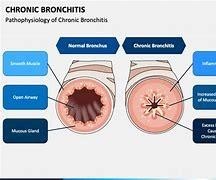A 68-year-old patient's chart indicates the following symptoms: chronic cough with sputum, cyanosis, and tachypnea. The patient is noted to have nicotine dependence ACT report shows clogged passageways due to mucus. The patient is getting treated with steroid inhalation Which condition is this patient being treated for?
Pneumoconiosis
Chronic bronchitis
Bronchiectasis
Pulmonary emphysema
The Correct Answer is B
Chronic bronchitis is a type of chronic obstructive pulmonary disease (COPD) that causes inflammation and excess mucus production in the bronchial tubes. The main risk factor for chronic bronchitis is smoking. The symptoms of chronic bronchitis include chronic cough with sputum, cyanosis (bluish skin due to low oxygen levels), and tachypnea (rapid breathing). Steroid inhalation is one of the treatments for chronic bronchitis, as it helps reduce inflammation and improve airflow.

Nursing Test Bank
Naxlex Comprehensive Predictor Exams
Related Questions
Correct Answer is C
Explanation
Painless hematuria is the most common symptom of bladder cancer, which is a malignant tumor that arises from the urothelial cells that line the bladder.
Hematuria is the presence of blood in the urine that can be gross or microscopic. Bladder cancer can also cause other symptoms such as dysuria, frequency, urgency, or pelvic pain.
Correct Answer is B
Explanation
Oliguria is a condition where the urine output is less than normal, usually less than 500 mL per day in adults. Oliguria can be a sign of dehydration, which occurs when the body loses more water than it takes in. Dehydration can cause various symptoms such as thirst, dry mouth, headache, dizziness, fatigue, and confusion.
Dehydration can also affect kidney function and lead to electrolyte imbalances and acid-base disorders.
Whether you are a student looking to ace your exams or a practicing nurse seeking to enhance your expertise , our nursing education contents will empower you with the confidence and competence to make a difference in the lives of patients and become a respected leader in the healthcare field.
Visit Naxlex, invest in your future and unlock endless possibilities with our unparalleled nursing education contents today
Report Wrong Answer on the Current Question
Do you disagree with the answer? If yes, what is your expected answer? Explain.
Kindly be descriptive with the issue you are facing.
